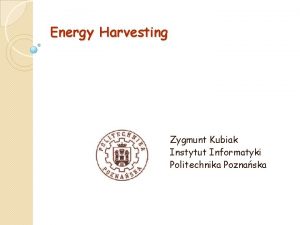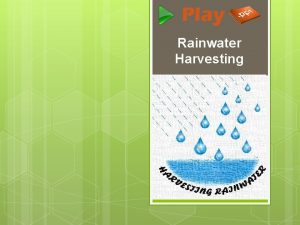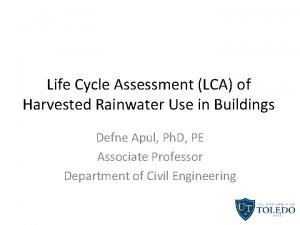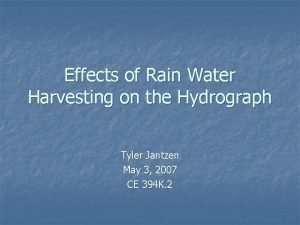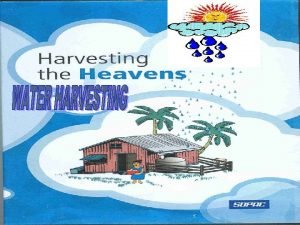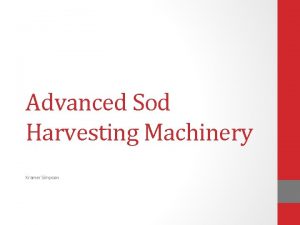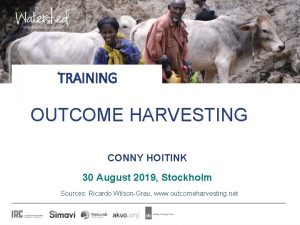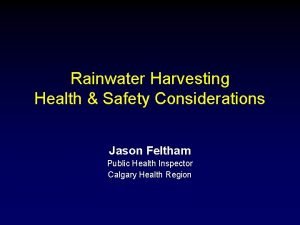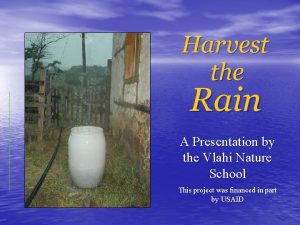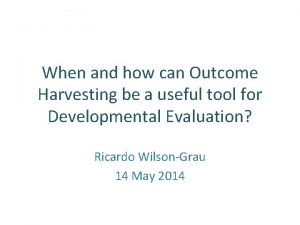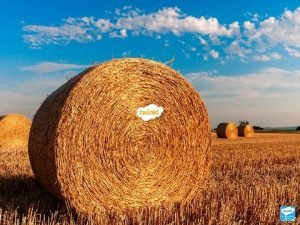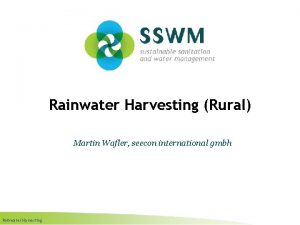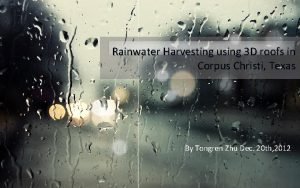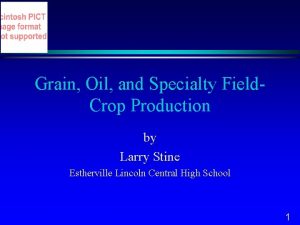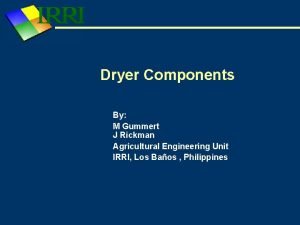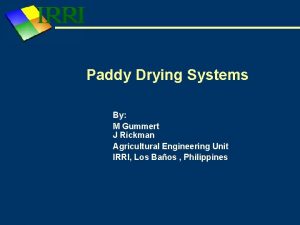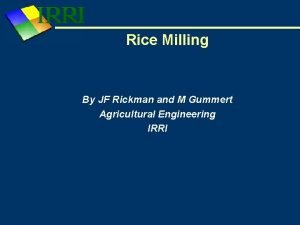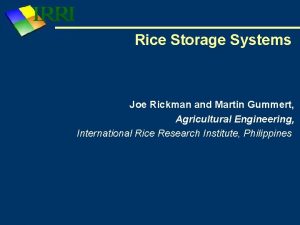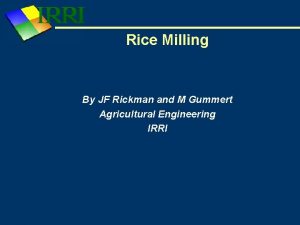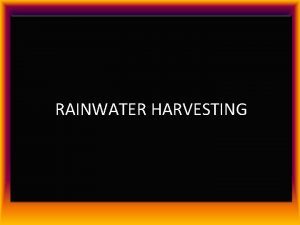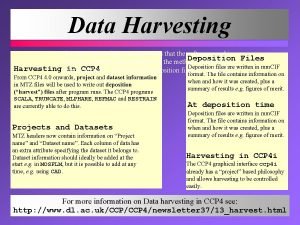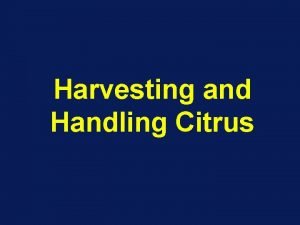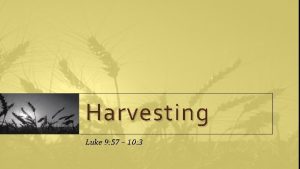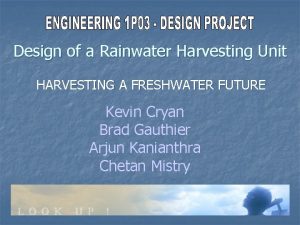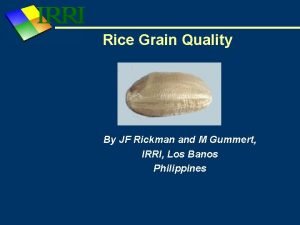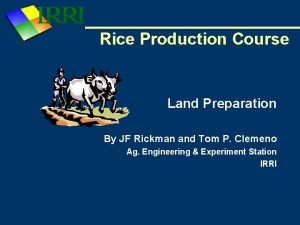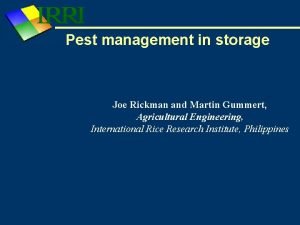Harvesting JF Rickman Agricultural Engineering M Gummert Agricultural





























- Slides: 29

Harvesting JF Rickman, Agricultural Engineering, M Gummert, Agricultural Engineering IRRI, Los Baños , Philippines

Content • • • Introduction What is harvesting Harvesting systems When to harvest How to harvest (technology options) • Harvest losses • Recommendations

Introduction Harvesting is the process of collecting the mature rice crop from the field. • Cutting: cutting the panicles and straw. • Hauling: moving the cut crop to the threshing location. • Threshing: separating the paddy grain from the rest of the cut crop. • Cleaning: removing immature, unfilled and non -grain materials. • Field drying: (optional) leaving the cut crop in the field and exposing it to the sun for drying. • Stacking / Piling: (optional) temporarily storing the harvested crop in stacks or piles.

Good harvesting practices At harvest the quality of rice is best. From then on it can deteriorate quickly: • Heat build up from mold and insect development • Discoloration/Yellowing from heat build-up • Cracking from re-wetting of dried grains • Loss of vigor • Reduced head rice yield • Shattering losses Goals of good harvesting: • maximize grain yield (minimize losses) • minimize grain damage • Minimize quality deterioration

Harvesting systems 1. Manual system • Manual operation sometimes using tools • Labor requirement: 48 person days / ha

Harvesting systems 2. Manual cutting / machine threshing Optional: Winnowing or cleaning • Labor requirement: 28 person days/ha • Capital cost appr. : US$ 1000

Harvesting systems 2. Machine cutting / machine threshing Optional: Winnowing or cleaning • Capacity reaper: • Capacity thresher: • Capital cost approx. : US$ 2, 500

Harvesting systems 4. Combine harvesting • Cutting, hauling, threshing, cleaning in one combined operation • Capacity: > 0. 5 ha/h • Labor requirement: 1 Operator • Capital cost: > $ 250, 000

When to harvest Harvest rice when: • 20 -25% grain moisture • 80 -85% straw colored and • the grains in the lower part of the panicle are in the hard doe stage • 30 days after flowering

Manual cutting and hauling • Capacity: 0. 07 ha/person day • Advantages – effective in lodged crop – less weather dependent • Problems – high labor cost – labor dependent, competes with other operations in peak season – winnowing/cleaning necessary

Mechanical reaping • Capacity: 2 -4 ha/d • Advantages – Fast cutting • Problems – Places crop in window back in the field – Problem with lodged crop – Complex cutter bar and conveying mechanism

Manual threshing • Capacity: approximately 15 person days/ha • Threshing by impact • High shattering losses • Pre-drying might be needed

Pedal thresher • Capacity: • Principle – Wire loop threshing drum – Mainly combing the grains off the straw, some threshing by impact • Advantages – Maintains the straw • Disadvantage – Needs winnowing after threshing Wire loop threshing drum

Axial-flow thresher • Capacity: 0. 3 -3 t/h • Threshing through impact • Large range of sizes available • With or without cleaner • Truck mounted units • Advantages – Can thresh wet crop – Compact produced in 9 different countries used by several 100, 000’s of rice farmers across Asia Peg tooth threshing drum Axial flow principle

Winnowing • Principle: lighter materials are blown away by air • Removes chaff, straw and empty grains • Hand or mechanical winnowing • Does not work for materials heavier than grain (dirt, stones)

Cleaning • Combination of fan and oscillating sieves • Air delivered by fan removes lighter materials • Top sieves with large holes remove larger straw particles • Bottom sieves with smaller holes remove small seeds (e. g. weed seeds)

Combine harvesting • Features – capacity: 4 -8 ha/day – combines cutting, threshing, cleaning and hauling – tracks for mobility in wet fields • Advantages – high capacity – low total harvest losses • Disadvantages – Requires relatively large field sizes – Problem in terraced fields

Stripper harvesting • Capacity: 1 ha/day • Advantages – strips and collects grains only – less material to handle • Problems – problems in wet soils and lodged crop – straw treatment – does not work well with long straw – complex machine – skills required Despite strong promotion in SE-Asia the stripper harvester has not gained wide popularity because of its problems in less favorable harvesting conditions

Losses during cutting • Shattering loss = premature shedding of mature grains from the panicle caused by birds, wind, rats, and handling operations. Certain rice varieties shatter more easily than others. • Lodging loss = plants with mature grains in the panicles fall on the ground making the grains difficult to recover. • Standing crop loss = standing plants with mature grains are left standing in the field after harvesting operations as a result of oversight, carelessness or haste.

Losses during threshing • Separation loss or “blower loss” = mature grains that are mixed with straw or chaff during the cleaning operation. • Scatter loss = mature grains that are scattered on the ground during the threshing and cleaning operation. • Threshing loss = mature grains that remain attached to the panicle in the straw after completion of the threshing operation. High threshing efficiency will lead to low threshing loss, and vice versa.

Recommendations for optimizing quality • • Harvest at the right time and moisture content Avoid stacking the cut crop in the field Avoid delays in threshing after harvesting Use the proper machine settings when using a threshing machine • Clean the grain properly after threshing • Avoid delay in drying after threshing

Tips for manual threshing • Thresh as soon as possible after cutting • Hand thresh at lower moisture • Place a large canvas under the threshing frame to minimize shatter loss

Tips for machine threshing • Thresh as soon as possible after cutting • Level the thresher • Set machine correctly – drum speeds in thresher (600 rpm) – air flow in the cleaner – angle in the cleaner sieves

Thank you

Setting threshing drum speed Always adjust the thresher correctly. • For peg-tooth drums the drum tip speed should be about 12 -16 m/sec (see Table for correct RPM). • Higher speeds result in higher grain damage and de-hulled grains. • Lower speeds increase the amount of non-threshed grain and result in grain loss. Lower speeds also decrease throughput of the thresher. RPM Tip speed (m/s) for drum diameters of 30 cm 40 cm 50 cm 400 6. 3 8. 4 10. 42 450 7. 07 9. 4 11. 78 500 7. 85 10. 5 13. 09 550 8. 64 11. 5 14. 4 600 9. 42 12. 6 15. 7 650 10. 21 13. 6 17. 02 700 11 14. 7 18. 3 750 11. 8 15. 7 19. 64 800 12. 6 16. 8 21 850 13. 4 17. 8 22. 25 900 14. 14 18. 85 23. 6

Setting concave clearance Concave clearance • For most threshers clearances between pegteeth and concave should be about 25 mm. • Smaller clearance increases grain damage and might lead to clogging of straw. • Larger concave clearances reduce threshing efficiency.

Axial flow thresher

Combine harvester

Tips for good winnowing • • Place grain on a winnowing tray Place a net or mat on the ground Tilt the tray against the wind Pour grain slowly at a height of about 1 m Wind will separate light from heavy grains Recover only the heavier grains Repeat the procedure, if needed Use a fan or blower if there is insufficient wind.
 Joe rickman
Joe rickman Jf agricultural engineering
Jf agricultural engineering Energy harvesting przykłady
Energy harvesting przykłady Bibliography for rainwater harvesting
Bibliography for rainwater harvesting Negarim micro catchment
Negarim micro catchment Rainwater harvesting introduction
Rainwater harvesting introduction Direct harvesting
Direct harvesting Autonomous data harvesting
Autonomous data harvesting Life cycle assessment of rainwater harvesting
Life cycle assessment of rainwater harvesting Rain water harvesting
Rain water harvesting Conclusion of rain water harvesting
Conclusion of rain water harvesting Harvesting ideas adalah
Harvesting ideas adalah Chapter 9 cellular respiration harvesting chemical energy
Chapter 9 cellular respiration harvesting chemical energy Sod harvesting
Sod harvesting Harvesting strategy
Harvesting strategy Outcome harvesting training
Outcome harvesting training Rainwater harvesting calgary
Rainwater harvesting calgary Conclusion of rainwater harvesting
Conclusion of rainwater harvesting The stages of cellular respiration
The stages of cellular respiration Internlnet storing
Internlnet storing Fish harvesting methods
Fish harvesting methods Chapter 9: cellular respiration: harvesting chemical energy
Chapter 9: cellular respiration: harvesting chemical energy Rainwater harvesting systems cork
Rainwater harvesting systems cork Harvest collection
Harvest collection Function of rainwater harvesting
Function of rainwater harvesting Reference of rainwater harvesting
Reference of rainwater harvesting The primary harvesting machine used for field crops is the:
The primary harvesting machine used for field crops is the: Domestic rainwater harvesting systems
Domestic rainwater harvesting systems Coarse mesh in rainwater harvesting
Coarse mesh in rainwater harvesting Harvesting the venture
Harvesting the venture


